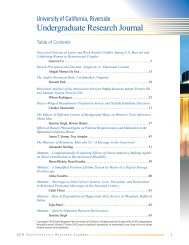2010 - Undergraduate Research, Scholarship and Creative Activity
2010 - Undergraduate Research, Scholarship and Creative Activity
2010 - Undergraduate Research, Scholarship and Creative Activity
Create successful ePaper yourself
Turn your PDF publications into a flip-book with our unique Google optimized e-Paper software.
Synthetic Analogs of An<strong>and</strong>amide <strong>and</strong><br />
Tetrahydrocannabinol<br />
Janel Gracia, Biochemistry<br />
Mentor: Michael J. Marsella<br />
Department of Chemistry<br />
Tetrahydrocannabinol (THC) is the main<br />
psychoactive component of cannabis sativa<br />
(marijuana), <strong>and</strong> an exogenous lig<strong>and</strong> that<br />
mimics endogenous an<strong>and</strong>amide (the ―bliss<br />
molecule‖). THC is used for its pharmaceutical<br />
effects, such as its use in Marinol® where it acts<br />
as an anti-emetic; it is also targeted for CNS<br />
disorders <strong>and</strong> pain management. The binding of<br />
THC (a CB 1 /CB 2 lig<strong>and</strong>) to its receptor is key to<br />
its function. Here, the objective is to synthesize<br />
analogs of these compounds, with the goal of<br />
developing lead compounds for treatment of<br />
depression, anxiety, schizophrenia, certain<br />
dementias, <strong>and</strong> other CNS disorders. These<br />
targets include CB 1 agonists/antagonists that<br />
mimic the desirable properties of<br />
endocannabinoids without inducing unwanted<br />
psychotropic effects. The key challenge is to<br />
synthesize a common core from which many<br />
different analogs can be produced. The present<br />
strategy is a conversion of a CBC analog to<br />
THC. Results to date will be presented.<br />
oxidation. Our focus is to oxidize these<br />
compounds in order to generate highly reactive<br />
. + ++<br />
<strong>and</strong> unknown P 2 <strong>and</strong> P 2 fragments<br />
stabilized by carbenes <strong>and</strong> characterize them.<br />
We first synthesized the imidazolium (NHC,<br />
HCl) precursor of the free carbene according to<br />
the literature. We then checked the product by<br />
13 C <strong>and</strong><br />
1 H Nuclear Magnetic Resonance<br />
(NMR). We generated the free NHC by<br />
deprotonation of NHC, HCl with KOtBu <strong>and</strong><br />
reacted it with PCl 3 to form a NHC- PCl 3 adduct<br />
which was then reduced using KC 8 to make<br />
NHC- P 2 - NHC, characterized by 1 H, 13 C <strong>and</strong> 31 P<br />
NMR. The Cyclic Voltamperometry of the<br />
compound showed that it can undergo two one<br />
electron reversible oxidations. According to this<br />
analysis we will chemically carry out a one<br />
electron oxidation to generate the corresponding<br />
radical cation [NHC- P 2 - NHC] +. which will<br />
be characterized by a EPR <strong>and</strong> x-ray diffraction<br />
study. We will then oxidize NHC-P2-NHC twice<br />
to get the diamagnetic dication [NHC- P 2 -<br />
NHC] ++ which will be characterized by 31 P, 13 C<br />
<strong>and</strong> 1 H NMR <strong>and</strong> x-ray diffraction. Finally we<br />
will study the reactivity of this dication which is<br />
predicted to contain a highly reactive<br />
diphosphene moiety.<br />
Synthesis of P 2<br />
+ . <strong>and</strong> P 2 ++ Fragments<br />
Stabilized by Nitrogen Heterocyclic Carbene<br />
(NHC) <strong>and</strong> Cyclic Alkyl Amino Carbene<br />
(CAAC)<br />
Mellissa Gray, Chemistry<br />
Contributor: Olivier Back<br />
Mentor: Guy Bertr<strong>and</strong><br />
Department of Chemistry<br />
Very recently carbenes have been used to<br />
stabilize highly reactive transitient species based<br />
on main group elements. Indeed, once stabilized,<br />
conventional analysis can be used to gain more<br />
insight into their structure, but very few<br />
examples of stabilized cationic or radical<br />
fragments are known. Recently, P 2 carbene<br />
adducts containing two very electron rich<br />
phosphorous atoms have been made by using<br />
Childhood Trauma, Alexithymia, <strong>and</strong><br />
Problematic Internet Use in Young<br />
Adulthood<br />
(Cancelled)<br />
Margo Gregor, Psychology<br />
Mentor: Tuppett Yates<br />
Department of Psychology<br />
Over the past several years, technological<br />
advances have rendered the internet increasingly<br />
accessible. This growth in internet accessibility,<br />
however, has surpassed our underst<strong>and</strong>ing of its<br />
developmental effects, particularly with respect<br />
to the potential for problematic or addictive use.<br />
This study builds on a small literature base,<br />
which has primarily evaluated correlates of<br />
problematic internet use (PIU). Previous<br />
research has linked maladaptive internet use to<br />
increased levels of loneliness, selfconsciousness,<br />
anxiety, depression, impulsivity,<br />
NHC <strong>and</strong> CAAC <strong>and</strong> are then prone to<br />
Fourth Annual UCR Symposium for <strong>Undergraduate</strong> <strong>Research</strong>, <strong>Scholarship</strong> <strong>and</strong> <strong>Creative</strong> <strong>Activity</strong><br />
30














